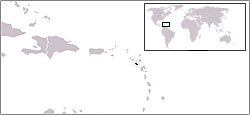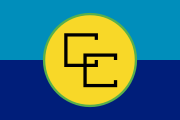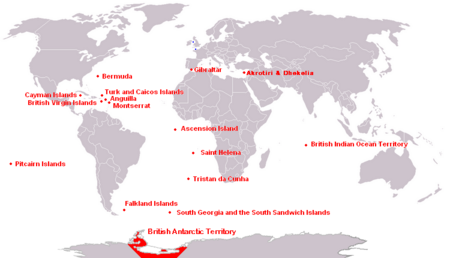Montserrat
|
Montserrat
|
||||||
|---|---|---|---|---|---|---|
|
||||||
| Anthem: "God Save the Queen" |
||||||
 |
||||||
| Capital | Plymouth 1 Brades (de facto) |
|||||
| Official languages | English | |||||
| Ethnic groups | West African, Mulatto, English, Irish[1] | |||||
| Government | British Overseas Territory | |||||
| - | Queen | Elizabeth II | ||||
| - | Governor | Peter Andrew Waterworth | ||||
| - | Chief Minister | Lowell Lewis | ||||
| British overseas territory | ||||||
| - | British control established | 1632 | ||||
| Area | ||||||
| - | Total | 102 km2 (219th) 39 sq mi |
||||
| - | Water (%) | negligible | ||||
| Population | ||||||
| - | July 2005 estimate | 4,488 (216th) | ||||
| GDP (PPP) | 2002 estimate | |||||
| - | Total | $29 million (not ranked) | ||||
| - | Per capita | $3,400 (not ranked) | ||||
| HDI | n/a (unranked) (n/a) | |||||
| Currency | East Caribbean dollar (XCD) |
|||||
| Time zone | (UTC-4) | |||||
| Internet TLD | .ms | |||||
| Calling code | 1 664 | |||||
| 1 | Abandoned in 1997 following a volcanic eruption. Government buildings are currently located in Brades, making it the de facto capital. | |||||
| 2 | An estimated 8,000 refugees left the island following the resumption of volcanic activity in July 1995; some have returned. | |||||
Montserrat (pronounced /ˌmɒntsəˈræt/) is British overseas territory located in the Leeward Islands, part of the chain of islands called the Lesser Antilles in the Caribbean Sea. It measures approximately 16 km (10 miles) long and 11 km (7 miles) wide, giving 40 kilometres (25 mi) of coastline.[2] Montserrat was given its name by Christopher Columbus on his second voyage to the New World in 1493, after its namesake located in Catalonia. Montserrat is often referred to as the Emerald Isle of the Caribbean, due both to its resemblance to coastal Ireland and to the Irish descent of most of its early European settlers.
Its Georgian era capital city of Plymouth was destroyed and two-thirds of the island's population forced to flee abroad by an eruption of the previously dormant Soufriere Hills volcano that began on July 18, 1995.[3] The eruption continues today on a much reduced scale, the damage being confined to the areas around Plymouth including its docking facilities and the former W.H. Bramble Airport. An exclusion zone extending from the south coast of the island north to parts of the Belham Valley has been closed because of an increase in the size of the existing volcanic dome. This zone includes St. George's Hill which provided visitors with a spectacular view of the volcano and the destruction it has wrought upon the capital. A new airport at Gerald's in the northern part of the island opened in 2005. The village of Brades currently serves as the de facto centre of government.
Contents |
History
Montserrat was populated by Arawak and Carib people when it was claimed by Christopher Columbus on his second voyage for Spain in 1493, naming the island Santa María de Montserrate, after the Blessed Virgin of the Monastery of Montserrat, which is located on the Mountain of Montserrat, in Catalonia. The island fell under English control in 1632 when a group of Irish fleeing anti-Roman Catholic sentiment in Saint Kitts and Nevis settled there. The import of slaves (including many Irish slaves exiled there from Oliver Cromwell's reign of terror in Ireland), common to most Caribbean islands, mainly coming from West Africa, followed during the seventeenth and eighteenth centuries and an economy based on sugar, rum, arrowroot and Sea Island cotton was established.
In 1782, during the American Revolutionary War, Montserrat was briefly captured by France. It was returned to the United Kingdom under the Treaty of Paris which ended that conflict. A failed slave uprising on 17 March 1798 led to Montserrat later becoming one of only four places in the world that celebrates St Patrick's Day as a public or bank holiday (the others being the Republic of Ireland, Northern Ireland and the Canadian province of Newfoundland and Labrador). Slavery was finally abolished in Montserrat in 1834, presumably as a result of the general emancipation of slaves within the British Empire in that same year.
Falling sugar prices during the nineteenth century had an adverse effect on the island's economy and in 1869 the philanthropist Joseph Sturge of Birmingham formed the Montserrat Company to buy sugar estates that were no longer economically viable. The company planted limes starting production of the island's famous lime juice, set up a school, and sold parcels of land to the inhabitants of the island, with the result that much of Montserrat came to be owned by smallholders.[4]
From 1871 to 1958 Montserrat was administered as part of the Federal Colony of the Leeward Islands, becoming a province of the short-lived West Indies Federation from 1958 to 1962. With the completion of Beatles producer George Martin’s AIR Studios Montserrat in 1979, the island attracted world-famous musicians who came to record in the peace and quiet and lush tropical surroundings of Montserrat.[5]
The last several years of the 20th century, however, brought two events which devastated the island. In September 1989, Hurricane Hugo struck Montserrat with full force, damaging over 90 percent of the structures on the island. AIR Studios closed, and the tourist trade upon which the island depended was nearly wiped out. Within a few years, however, the island had recovered considerably—only to be struck again by disaster.
In July 1995, Montserrat's Soufriere Hills volcano, dormant throughout recorded history, rumbled to life and began an eruption which eventually buried the island's capital, Plymouth, in more than 12 metres (39 ft) of mud, destroyed its airport and docking facilities, and rendered the southern half of the island uninhabitable. This forced more than half of the population to flee the island because they lacked housing. After a period of regular eruptive events during the late 1990s including one on June 25, 1997 in which 19 people lost their lives, the volcano's activity in recent years has been confined mostly to infrequent ventings of ash into the uninhabited areas in the south. However, this ash venting does occasionally extend into the populated areas of the northern and western parts of the island. As an example, on May 20, 2006, the lava dome that had been slowly building collapsed, resulting in an ashfall of about an 2.5 cm (1 inch) in Old Towne and parts of Olveston. There were no injuries or significant property damage.
Long referred to as "The Emerald Isle of the Caribbean" for both its Irish heritage and its resemblance to coastal Ireland, Montserrat today remains lush and green. A new airport, opened officially by the Princess Royal Princess Anne in February 2005, received its first commercial flights on July 11, 2005, and docking facilities are in place at Little Bay where a new capital is being constructed out of reach of any further volcanic activity.
The people of Montserrat were granted full residency rights in the United Kingdom in 1998, and citizenship was granted in 2002.
Primary schools
- Government Primary Schools—Brades, and Look Out Primary.
- St. Augustine Roman Catholic School (Palm Loop, Montserrat)
Parishes
Montserrat is divided into three parishes:
- Saint Anthony Parish
- Saint Georges Parish
- Saint Peter Parish
Villages
- Cudjoe Head
- Baker Hill
- Brades (de facto capital)
- Davy Hill
- Banks
- Farells Yard
- Flemmings
- Gerald's
- Hope
- Little Bay
- Look Out, Montserrat
- Old Towne, Montserrat
- Olveston
- Plymouth (official capital, abandoned)
- Cavalla Hill
- Mongo Hill
- Saint John's
- Judy Piece
- Salem
- Sweeney's, Montserrat
- Woodlands
- St Peter's
- Virgin Island
- Drummonds
Geography


The island of Montserrat is located approximately 480 km (300 miles) east-southeast of Puerto Rico and 48 km (30 miles) southwest of Antigua. It comprises only 104 km² (40 square miles) and is increasing gradually owing to volcanic deposits on the southeast coast of the island; it is 16 km (10 miles) long and 11 km (7 miles) wide, with dramatic rock faced cliffs rising 15 to 30 m (50-100 feet) above the sea and smooth bottomed sandy beaches scattered among coves on the west side of the island. Montserrat has been a quiet haven of extraordinary scenic beauty.
Montserrat has two islets: Little Redonda and Virgin.
The Soufrière Hills or Montserrat volcano is an active complex stratovolcano with many lava domes forming its summit on the island. After a long period of dormancy it became active in 1995, and eruptions have continued up to the present. The last major eruption was in July 2003.
Economy
It was formerly the home of a branch of George Martin's AIR Studios (and other amenities) that made the island popular with working and vacationing musicians and other celebrities, celebrities often went there to record their songs in the recording studios.
Famous Montserratians
- Alphonsus "Arrow" Cassell, MBE born in Montserrat is well known for his soca song "Hot Hot Hot" which has sold over 4 million copies. [1]
- Jim Allen—A former cricketer who represented the World Series Cricket West Indians.
- Junior Mendes—A professional footballer who has represented Montserrat twice in international games, currently playing for Aldershot Town in the Football League 2
- Shabazz Baidoo—A football player of Montserrat descent, plays in Football League 2 for Dagenham & Redbridge.
- Tesfaye Bramble—A football player, currently unattached, but who most recently played in the Conference National in England for Stevenage Borough.
- David Jordan - A singer songwriter who has reached number 4 in the UK charts. His mother was from Montserrat.
- Ruel Fox (footballer)—A football player, played for Norwich City, Newcastle United, Tottenham Hotspur and West Bromwich Albion. He is currently coach of non-league Whitton United F.C., who play in the Ridgeons League..
Demographics
Population: 4,819 (2007 estimate)
Note: an estimated 8,000 refugees left the island following the resumption of volcanic activity in July 1995; few have returned. Pre-eruption population was 13,000 in 1994.
Age structure:
- 0-14 years: 23.4% (male 1,062; female 1,041)
- 15-64 years: 65.3% (male 2,805; female 3,066)
- 65 years and over: 11.3% (male 537; female 484) (2003 est.)
Median age:
- total: 27.8 years
- male: 27.7 years
- female: 27.9 years (2002)
Population growth rate: 4.5% (2003 est.)
Birth rate: 17.57 births/1,000 population (2003 est.)
Death rate: 7.34 deaths/1,000 population (2003 est.)
Net migration rate: 195.35 migrant(s)/1,000 population (2000 est.)
Sex ratio:
- at birth: 1.05 male(s)/female
- under 15 years: 1.02 male(s)/female
- 15-64 years: 0.91 male(s)/female
- 65 years and over: 1.11 male(s)/female
- total population: 0.96 male(s)/female (2000 est.)
Infant mortality rate:
- total: 7.77 deaths/1,000 live births (2003 est.)
- female: 6.43 deaths/1,000 live births
- male: 9.05 deaths/1,000 live births
Life expectancy at birth:
- total population: 78.36 years
- male: 76.24 years
- female: 80.59 years (2003 est.)
Total fertility rate: 1.8 children born/woman (2003 est.)
HIV/AIDS—adult prevalence rate: NA%
HIV/AIDS—people living with HIV/AIDS: NA
HIV/AIDS—deaths: NA
Nationality:
- noun: Montserratian(s)
- adjective: Montserratian
Ethnic groups: black, white—mainly of mixed Irish and African descent
Religions: Anglican, Methodist, Roman Catholic, Pentecostal, Seventh-Day Adventist, other Christian denominations
Languages: English
Literacy:
- definition: age 15 and over has ever attended school
- total population: 97%
- male: 97%
- female: 97% (1970 est.)
Culture
- See also: Music of Montserrat and Cricket in the West Indies
Cricket is a popular sport in Montserrat players from Montserrat are in fact eligible to play for the West Indies cricket team. Jim Allen was the first to play for West Indies and he represented the World Series Cricket West Indians. No other player from Montserrat had gone on to represent West Indies until Lionel Baker made his One Day International debut against Pakistan in November 2008.[6]
Montserrat has its own FIFA Affiliated Football Team, and has twice competed in the World Cup qualifiers. A field for the team was built near the airport by FIFA. The Montserrat team are currently tied for 199th place in the FIFA world rankings with eight other teams, including American Samoa and Guam. In 2002, the team competed in a friendly with the second-lowest-ranked team in FIFA at that time, Bhutan, in The Other Final- the same day as the final of the 2002 World Cup. Bhutan won 4-0.
Miscellaneous topics
- Communications in Montserrat
- Radio Antilles
- Radio Montserrat
- Transport in Montserrat
- Montserratian British - there are more Montserratians in the UK than Montserrat
Operation Montserrat
Currently, American and British elementary and middle school students are eligible to participate in an Operation Montserrat live simulation. This is a videoconference program based on events of 1996 in which a hurricane approaches and a volcanic eruption occur nearly at the same time. The students are responsible for rescuing all of the people. In the weeks leading up to this, they practice the skills they need in their classroom.[7]
Loughborough University
In September 2003, Geography Students from Loughborough University lead by tutors Dr. Tracy Skelton and Prof. Joanne Bullard, visited the island to conduct studies on the socio-economic impact of the Soufriere Hills Volcano since it's first major eruption in 1997. Their work included project work based upon those residents of the Island that remained or had returned since the establishment of the de facto capital at Brades and visits to local schools. Trips to the Island have continued since as part of a final year field trip. Details of the trip can be found at www.lboro.ac.uk/geography.
References
- ↑ History/Irish Heritage
- ↑ Montserrat CIA World Factbook, 19 September, 2006. Retrieved 1 October 2006.
- ↑ Montserrat Volcano Observatory Retrieved 2 October 2006.
- ↑ Commonwealth Secretariat website: Montserrat. Retrieved 30 January 2007.
- ↑ George Martin Music: Montserrat
- ↑ Late Show Wins It For Pakistan In Abu Dhabi
- ↑ e-Mission: Operation Montserrat The Operation Montserrat website. Retrieved 1 May 2007
External links
- Government of Montserrat
- Montserrat Hospitality Association
- Montserrat Reporter news site
- Montserrat Tourist Board
- Montserrat travel guide from Wikitravel
- Montserrat Travel Information
- Montserrat Volcano Observatory
- Montserrat Webdirectory
- Official release archive
- Radio Montserrrat—ZJB Listen live online
- Satellite image of Montserrat from Google Maps
- Volcanism of Montserrat
- Scuba Diving in Montserrat
|
|
|||||||||||||||||||||||||||||||||||||||||||||||||||||||||||||||||
|---|---|---|---|---|---|---|---|---|---|---|---|---|---|---|---|---|---|---|---|---|---|---|---|---|---|---|---|---|---|---|---|---|---|---|---|---|---|---|---|---|---|---|---|---|---|---|---|---|---|---|---|---|---|---|---|---|---|---|---|---|---|---|---|---|---|
|
|||||||||||||||||||||||||||||||||||||||||||||||||||||||||||||||||
|
|
||||||||||||||||||||||||||||||||||||||||||||||||||||||||||||||||||||||||||||||||||||||||||||
|---|---|---|---|---|---|---|---|---|---|---|---|---|---|---|---|---|---|---|---|---|---|---|---|---|---|---|---|---|---|---|---|---|---|---|---|---|---|---|---|---|---|---|---|---|---|---|---|---|---|---|---|---|---|---|---|---|---|---|---|---|---|---|---|---|---|---|---|---|---|---|---|---|---|---|---|---|---|---|---|---|---|---|---|---|---|---|---|---|---|---|---|---|
|
||||||||||||||||||||||||||||||||||||||||||||||||||||||||||||||||||||||||||||||||||||||||||||



